BBC Features Rebecca Nelson and Aquaponics 13 Jan 6:01 AM (9 months ago)
The Conversation, a BBC podcast with listeners around the world, recently featured two female farming entrepreneurs, Rebecca Nelson, CEO, Nelson and Pade, Inc., and Grace Lim, Urban Farming Partners in Singapore. The podcast was recorded in London with the host in Washington DC, Rebecca in Florida, and Grace in Singapore. This fascinating show provided a platform for discussion about indoor farming and the need for and impact of soilless farming technology.
The post BBC Features Rebecca Nelson and Aquaponics first appeared on Nelson & Pade Aquaponics.DIY Aquaponics 10 Jul 2023 8:09 AM (2 years ago)
Contributed by: Rebecca Nelson
Can you be successful in aquaponics as a (DIY) Do-It-Yourself Builder?
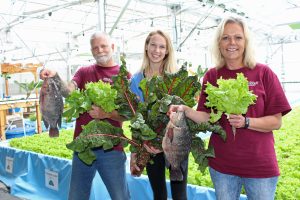 If you search YouTube and other sites on the internet, you will find many variations of DIY Aquaponics plans, from simple aquarium-based hobby kits to commercial farm ideas and plans, most of which do not provide quite enough information or detail to successfully build and operate an aquaponic farm.
If you search YouTube and other sites on the internet, you will find many variations of DIY Aquaponics plans, from simple aquarium-based hobby kits to commercial farm ideas and plans, most of which do not provide quite enough information or detail to successfully build and operate an aquaponic farm.
For many years, we have looked at DIY Aquaponics as a likely path to failure in aquaponic farming because that is often what happened to the DIY aquaponic farms in the past. DIY aquaponic builders often had an abundance of enthusiasm and just enough info to get the aquaponic system to almost function well.
What was lacking in many DIY Aquaponic farms for long-term success was a proven system design, years of experience, comprehensive training, detailed assembly and operation manuals and SOPs (Standard Operating Procedures) with an emphasis on food safety. These are the things that have led to repeatable successes for Nelson and Pade’s clients, who operate systems in nearly every US state and over 35 countries.
Looking at the industry as a whole and wanting to continue to assist as many people as possible to be successful in aquaponics, we stepped back to consider how we could help more people who want to embrace our proven systems, yet also have some knowledge and skills to contribute to the build process.
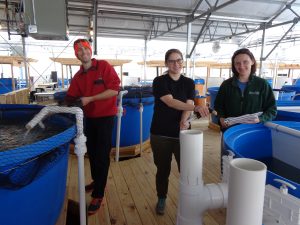 DIYers are generally pretty savvy at building things and quite resourceful when it comes to finding parts needed. Often, they might be in a related trade or business that could have access to labor, parts or skills that can be applied to building an aquaponic farm.
DIYers are generally pretty savvy at building things and quite resourceful when it comes to finding parts needed. Often, they might be in a related trade or business that could have access to labor, parts or skills that can be applied to building an aquaponic farm.
After thinking this all over, we realized that we can bring Aquaponics DIYers together to work with Nelson and Pade to achieve a better end-goal…a lower cost, more efficient and profitable aquaponic farm.
This discussion led to the development of a whole new line of aquaponic system offerings, which are a fraction of the cost of complete aquaponic systems and allow new and existing growers to utilize their labor and skills to save money. Essentially, Nelson and Pade Commercial Aquaponic Systems and Aquaponic MicroFarms are now available as kits, modules or complete packages.
With our new system offerings, a DIYer can put their skills to good use and save big money on establishing an aquaponics farm, yet rely on our proven, science-based aquaponic system designs, methods and procedures.
For a savvy builder who can source common parts and take on some of the assembly, the base system is all that they need.
Beyond the base system, there are a variety of additional items that the buyer can source and build locally or purchase from Nelson and Pade, Inc®. This flexibility creates a money-saving platform for each customer to excel and save where they want to, but rely on the proven, science-based Nelson and Pade, Inc® system designs throughout the process.
The complete system packages, as they’ve been offered for many years, are still available for the grower who wants to purchase everything needed from Nelson and Pade, Inc®.
Nelson and Pade’s new system order forms allow you to select exactly what components you want to order and what you want to source and build locally. When you check all of the options on the order form, you get the complete system.
Starting with the base system, you can pick and choose what you want from Nelson and Pade, Inc®, source what you want locally, buy additional components when you are ready and spread your startup costs out over time. This strategy results in a much lower startup cost because you can do some of the work yourselves, source components locally and save on labor and freight.
If you are interested in getting started in aquaponic farming, but were hesitant because of the cost, this new approach might be just what you need to advance your project. It will save you money on labor, parts and freight and allows you to apply your skills and finesse to complete the aquaponic system installation.
So, can you be successful as a DIY Aquaponics Farmer?
We believe that now you can, with the right design, plans and support from Nelson and Pade, Inc.
Check out our new aquaponic system offerings and ask us for spec sheets and pricing. If you are a DIYer, as you look through the new aquaponic system order forms, you can pick the items you want to purchase from Nelson and Pade and then build the rest on your own, using your skills and time. We even provide estimated shopping lists for the components that you’ll buy locally.
Ready to start your aquaponic farm?
Let’s chat!
888-798-6378
Or email: info@aquaponics.com
The post DIY Aquaponics first appeared on Nelson & Pade Aquaponics.The Need for Aquaponics in 2023! 19 Jan 2023 7:36 AM (2 years ago)
And, how you can get started in Commercial Aquaponic Farming!
 Are you looking for an innovative, sustainable and profitable business model for a full time or part time business? Aquaponic food production might be exactly what you have been seeking. It is an excellent fit for many reasons.
Are you looking for an innovative, sustainable and profitable business model for a full time or part time business? Aquaponic food production might be exactly what you have been seeking. It is an excellent fit for many reasons.
The need for aquaponics continues to increase, with the high cost of food and the unstable supply chain. Here we are, in early 2023. Inflation has driven food costs to the highest we’ve ever seen. So, maximizing production while reducing inputs is the key to success in the food industry, or any industry for that matter. And, aquaponics allows you to grow food for local markets, reducing the cost, damage and complexity of long distance transportation of fresh food.
Aquaponic farming can produce large quantities of fresh fish and vegetables. When combined with controlled environment agriculture, also called indoor farming, aquaponics can be done year-round in any climate.
Setting up a commercial aquaponic farm and making it your full-time career is very achievable with a science-based system, proper training and support. Or, establishing a smaller MicroFarm aquaponic system and growing part time, selling retail is another great approach to getting started.
Aquaponic farmers compete against field grown and hydroponic produce. Aquaponic vegetables are superior in quality to both of these methods. Now, with the high cost of vegetables in grocery stores, the playing field is leveled and aquaponic produce stands out as the best choice based on both quality and price.
Once of the greatest benefits of aquaponics is the increased production of fresh fish and vegetables. Using Nelson and Pade, Inc.’s commercial aquaponic systems you will use approximately 1/6th of the water to grow 8 times more food per acre compared to traditional agriculture! That is an enormous improvement over traditional farming methods. Plus, you have control of all inputs and can boast safe food production by preventing contamination though good agriculture practices and utilizing standard operating procedures.
One of the highest costs in farming are fertilizers. In aquaponics, you don’t use them! In an aquaponic system, the primary input is fish food. You feed the fish a high-quality diet so that they grow and stay healthy. The fish waste breaks down in a series of biological filter processes. The result is a steady stream of nutrients that plants need for growth. Therefor, the need for manufactured or mined fertilizers is eliminated.
Another great benefit of aquaponics is that you don’t need herbicides because there are no weeds. This saves a great deal of labor and resources as well. The need for pesticides is eliminated by using natural means of pest control.
This means that you grow food in aquaponics without the use of chemical fertilizers, pesticides or fertilizers. All of these factors come together to make aquaponics one of the most sustainable, efficient and productive methods of food production. The integrated systems produce both a fish and a vegetable crop.
Aquaponics can be used to grow food in a commercial farming venture, for home consumption, for food banks and other social programs or as a tool in education.
So, how do you get started?
Starting an aquaponic business is a new career for most who enter. In fact, most of the clients who purchase commercial aquaponic systems from Nelson and Pade, Inc.® are professionals who have never been involved in farming. Aquaponics appeals to them because of the sustainability, efficiency and profit potential.
How does someone with no experience in farming or aquaponics launch an aquaponics business? With the right system, education and support. The first step is to enroll in the Aquaponics Master Class®. This course is now available online and can be taken by anyone, anywhere, on your own time and schedule.
Following or during the Aquaponics Master Class®, the prospective grower should develop a business plan that represents their investment, operating costs, marketing plan and profitability. With the Aquaponics Master Class® complete and a business plan in hand, a new grower is ready to take the next steps to establish the business. These steps might include:
- Secure land (purchase or lease) in a desirable location
- Add any needed infrastructure
- Purchase a greenhouse and have it built
- Place the order for a Commercial Aquaponic System or a MicroFarm from Nelson and Pade, Inc.®
- Further develop the marketing plan, name, brand and logo
- Assemble the aquaponic system(s) and begin growing, following the detailed Assembly and Operations Manuals
- Utilize the Nelson and Pade SOPs (Standard Operating Procedures) to start up and operate the system
- Engage with the Nelson and Pade, Inc.® Tech Support Team when you have questions
Nelson and Pade, Inc.® has provided aquaponic systems to clients in nearly 40 countries. Uses range from commercial farming to home food production, from providing fresh food to food banks and school cafeterias to establishing classroom-based, living aquaponics laboratories.
If you’d like to learn more about how other people are using aquaponic systems from Nelson and Pade, Inc. to grow fresh food, please see the Case Studies at www.aquaponics.com.
You can learn more about aquaponics here.
The Team at Nelson and Pade, Inc. is dedicated to helping people around the world get started in aquaponics. Feel free to reach out to talk about your future in aquaponic food production.
Email: info@aquaponics.com
Phone: 608-297-8708
Different Types of Grow Lights in Desktop Aquaponics 16 Jan 2023 8:46 AM (2 years ago)
Everyone knows that plants need light to grow and photosynthesize, but there are different ways to accomplish this. Obviously, one option is to provide natural light, but in some cases this isn’t possible. Today I’ll talk about the different types of grow lights, and some pros of all of them.
The first one to talk about is Light Emitting Diode lights, better known as LED. This one is the most popular type of grow light, and it is the one I use in my aquaponics system at High Marq. The reason these are chosen more than other lights is because they don’t produce a lot of heat, are very durable, use less energy than other lights, and don’t have any harmful content like mercury.
 The second one is High Intensity Discharge Lights, or HID. These are also an extremely popular type of grow light, and there are good reasons for it. They can be run 24 hours a day and not change the temperature of the system, they don’t emit a lot of harmful wavelengths that can damage your plants, and like the LED lights, there is no harmful mercury. In the photo on the right, you see plants growing under HID lights.
The second one is High Intensity Discharge Lights, or HID. These are also an extremely popular type of grow light, and there are good reasons for it. They can be run 24 hours a day and not change the temperature of the system, they don’t emit a lot of harmful wavelengths that can damage your plants, and like the LED lights, there is no harmful mercury. In the photo on the right, you see plants growing under HID lights.
The last type of light is fluorescent lights. They are also quite popular, however not as popular as the last two lights mentioned. They also produce low heat, are typically very affordable, last longer than original bulbs, energy efficient, and are usually very accessible.
In general, any or all of these options are very good ones, and whichever you choose will provide light for your plants.
Please feel free to leave comments or questions below.
The post Different Types of Grow Lights in Desktop Aquaponics first appeared on Nelson & Pade Aquaponics.Potted Plants in Aquaponics 13 Dec 2022 8:01 AM (2 years ago)
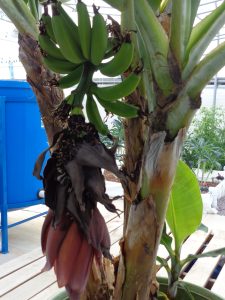 Most planting in aquaponics is in rafts, channels or media beds that are directly connected to the system, but you can also grow plants by putting them in pots that are not connected to the aquaponic system.
Most planting in aquaponics is in rafts, channels or media beds that are directly connected to the system, but you can also grow plants by putting them in pots that are not connected to the aquaponic system.
Using potted plants in aquaponics is extremely simple. You just plant anything like you would normally, except instead of soil, use expanded clay pebbles or other grow media. Giving water from the fish tanks gives the plants extra nutrients and helps them grow better.
Some of the things grown in the Nelson & Pade greenhouses using this method include coconut palms, citrus trees like limes and oranges, dinosaur kale, various herbs, aloe vera, and banana trees. In the photo on the right, a banana tree is growing in a pot. This method is a good way to grow things that you might not be able to grow in a raft because they need root support or are too big.
Because of the diversity of the types of plants you can grow like this and how easy it is to do, I recommend using this method to try to grow some stuff you can’t grow using a normal aquaponics set up.
If you have questions or comments, please share below! Thanks
The post Potted Plants in Aquaponics first appeared on Nelson & Pade Aquaponics.What fish are best for desktop aquaponics? 2 Nov 2022 5:04 AM (2 years ago)
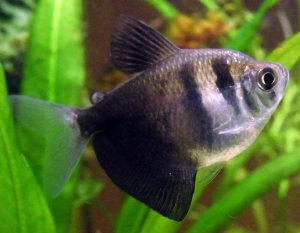 Last week, I wrote a blog about plants that work well in desktop aquaponics systems, but plants can’t grow without nutrients from fish. Fish are the other half of an aquaponics system, so it makes sense to be careful with what fish you put in it.
Last week, I wrote a blog about plants that work well in desktop aquaponics systems, but plants can’t grow without nutrients from fish. Fish are the other half of an aquaponics system, so it makes sense to be careful with what fish you put in it.
Since desktop aquaponics systems are very limited in tank space, it’s not usually used to grow fish as food. Because of that, small and decorative fish are typically used in desktop aquaponics. Fish like tetras, which is what my school has in our miniature aquaponics system, guppies, bettas, pencilfish, goldfish, and angelfish are all very popular options for small systems.
While all those fish are similar, they have different needs. For example, tetras need to live in schools, while male bettas have to live alone because they are agressive. Some fish may be able to live in small tanks, while a school may need much more space. It’s best to research these breeds and find what works best for your specific aquaponics set up before choosing a fish.
Feel free to post below and tell us what fish you are raising in aquaponics.
The post What fish are best for desktop aquaponics? first appeared on Nelson & Pade Aquaponics.Preparing for Seasonal Changes in an Aquaponics Greenhouse 8 Oct 2022 9:53 AM (3 years ago)
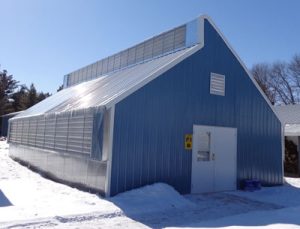
As the days get shorter and the temperatures begin to drop, it is important to monitor the changing conditions and be proactive in your preparations and procedures to save energy and avoid problems in an aquaponic farming operation. Within an aquaponic system, stability in temperature is critical to success in growing. The ambient air temperature is another important factor.
Many newer greenhouse controllers have the capability and technology to adjust the environmental control equipment automatically based on current conditions and weather. If your controller has these capabilities, it is wise to understand the programing and automation as well as the manual controls. It is important to change the greenhouse parameters based on the weather and crop needs in the aquaponics system.
There are several things you can do to prepare for extreme cold conditions or winter storms. The first course of action should be to check each piece of vital equipment in the aquaponic system and greenhouse, especially those essential for providing heat. It is during these times that it is imperative to thoroughly clean all water heaters and water pumps, test all monitoring/alarm equipment and back-up equipment and test-run generators.
Utilizing an interior energy curtain to retain heat is an excellent means of saving energy and maintaining the temperature. Installing Styrofoam around the perimeter of the greenhouse on the lower part of the sidewall will also help to retain heat.

If severe weather is forecast, closing the greenhouse vents and preventing them from opening during a storm can save your greenhouse from damage. Another tip is to increase the heat inside the greenhouse in preparation for an incoming snow or ice storm. Warming the greenhouse will provide heat in the ceiling area to help melt snow and ice that settles on the greenhouse roof. Keeping snow weight and ice off of your structure is important for proper vent operations and ensuring there is not too much weight accumulating for greenhouse to hold.
Be prepared, be ready and be creative in thinking through how you can adjust and adapt your structure to the most extreme weather conditions you might encounter. Aquaponic farming is a year ’round business and it is up to the owner to ensure that their greenhouse, aquaponics system and environmental control equipment can maintain proper temperature throughout the year.
The post Preparing for Seasonal Changes in an Aquaponics Greenhouse first appeared on Nelson & Pade Aquaponics.What plants are best for desktop aquaponics? 7 Oct 2022 7:07 AM (3 years ago)
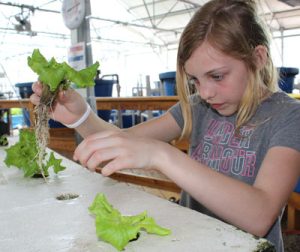
Aubrey planting aquaponic lettuce
Half of aquaponics is growing plants, but what are the best plants to grow in a desktop aquaponics system? While it heavily depends on the specific desktop system you have and the amount of space you have, there are still some plants that are much easier to grow than others.
Some plants that are easy to grow are herbs and salad greens. An example of some herbs that are good to grow in limited space are basil, oregano, mint, sage, parsley, thyme, and dwarf rosemary. Lettuce, arugula, mesclun, chard, baby spinach, and kale are all great examples of easy microgreens and salad greens to grow in a small aquaponics system.
You can also grow some more challenging plants in aquaponics like strawberries, container-type tomatoes, and hot peppers. These can be challenging because many fruiting plants like these might require hand pollination, higher levels of nutrients, or special conditions to bear any fruit.
My school is working on growing lettuce in our aquaponics garden. It’s a very good starter plant for us, and we are planning to experiment with peas, beans, and even cherry tomatoes in the future. Even though this list gives examples of easy to grow plants, it’s best to experiment with different plants and see what works best for you and your aquaponics system.
Please feel free to comment or ask questions below!
The post What plants are best for desktop aquaponics? first appeared on Nelson & Pade Aquaponics.Welcome to my Aquaponics Blog! 22 Sep 2022 2:24 PM (3 years ago)
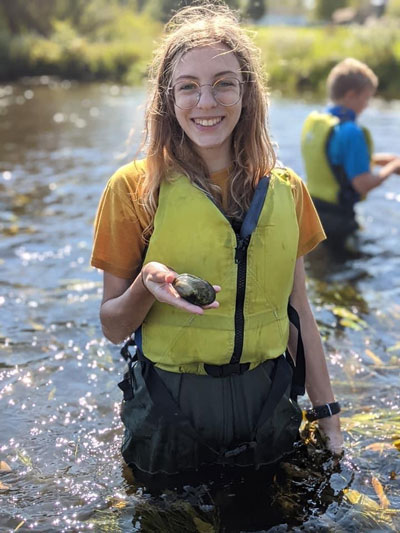
Aubrey’s Aquaponics Blog
Hello, I am Aubrey, I’m in 8th grade, and I’m 13 years old. I go to an environmental charter school in Wisconsin, and we have an aquaponic system in our school. We set up an Aquasprouts garden so we can have fresh food for the classroom and have a fun learning opportunity.
I really like aquaponics because it can be easy to start learning about it while still being fun to learn. You can grow fresh food on your desktop for you, your family, or to donate to your community or people in need. It’s also a really great way for people to learn about science. I love how much you can do with aquaponics, yet how easy it can be to maintain.
Part of the reason I like aquaponics so much is because of how much time I’ve spent around aquaponics and how many experiences I’ve had with it. My mom took a job with Nelson and Pade, Inc.® when I was 6, and I’ve loved it ever since. I used to love to feed the fish and seed and harvest lettuce in the green house. My school now has an aquaponic system, so I’ve been surrounded by it for most of my life. I can remember going on business trips with my mom to see aquaponic systems all around the U.S. and how much I loved seeing how different yet similar all the systems were.
I’m very excited to write more on this blog and expand my experience with aquaponics. I want to teach other kids and schools about aquaponics so they can learn and have fun just like I do. I hope that people will find this blog and share it with schools so they can have a better way of learning about fish, science, and aquaponics, and learn the responsibility of taking care of an aquaponics system, fish, plants, and all.
Feel free to leave a comment or ask a question below. I am happy to answer.
The post Welcome to my Aquaponics Blog! first appeared on Nelson & Pade Aquaponics.Does Aquaponic Farming Have a Difficult Learning Curve? 29 Aug 2022 1:21 PM (3 years ago)

Aquaponic Farming
Recently, during a talk on aquaponics with a group of farmers, questions arose about the learning curve of aquaponic farming.
It was something like this: “We are farmers. We know a lot about planting, growing and harvesting, but this seems like a really large learning curve to do commercially considering the handling of fish and plants and monitoring all of the elements. What background or training does someone need to do this successfully? Would we need to hire someone to manage this?”
It is always interesting to me when farmers question the learning curve of aquaponics. Traditional farming is one of the most complex processes there is, with significant risks due to weather, disease, pollution, rising fertilizer costs and the necessity for a massive amount of land. Most farms are inherited and knowledge, land and equipment has been passed down though the generations.
Taking just two crops, fish and vegetables, and raising them in an indoor, sustainable system that embraces the symbiotic relationship between these organisms is, in my mind, much simpler than managing a whole integrated farm with various animals, inputs and crops.
What probably best speaks to the “learnabilty” of our aquaponic systems is the diverse mix of people who operate them, from school teachers to start-up commercial farmers. Most of our clients using Clear Flow Aquaponic Systems® for commercial food production come from a background other than farming. Here are a few examples:
- BJ (an architect) and Cat (an electrical engineer) in AZ have been running a Nelson and Pade commercial aquaponic system for about 10 years. They are currently expanding their operation and their son is joining them in the operation of the aquaponic farm.
- Mike in Ohio is a successful aquaponic farmer who was a videographer. In fact, we met him when we hired him to do some promotional videos for us. He loved the concept so much, he enrolled in our training and project planning, bought land and one of our commercial aquaponic systems and started his aquaponic farm. He is now in the planning phase for a very large expansion to keep up with demand for his premium vegetables and “sashimi-grade” tilapia.
- Bob, who founded a Tech Company, and Lauri, a professional in the tech industry, established an aquaponic farm on the Caribbean island of Bonaire. They are now planning their second expansion.
None of these people had a background in raising fish or vegetables. In addition to these, we’ve had executives, medical professionals, school administrators and school teachers, entrepreneurs, architects, engineers, chefs, realtors, developers, ranchers, electricians, financial analysts, truckers and people from a variety of other backgrounds purchase our commercial aquaponic systems and operate them successfully.
Keep in mind, we don’t just sell a system. The manuals, training courses, processes and procedures developed by Nelson and Pade, Inc.® provide our customers with the knowledge they need for startup and the day-to-day operations. When a question arises, growers utilize our grower support program to quickly get answers.
If someone has a willingness to learn and follow our manuals and procedures and an eagerness to be successful in aquaponics, they can successfully operate our aquaponic systems.
What is Aquaponics? Learn more now!
The post Does Aquaponic Farming Have a Difficult Learning Curve? first appeared on Nelson & Pade Aquaponics.